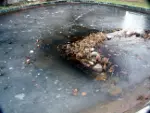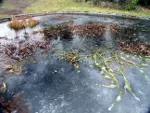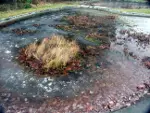Feeding your pond fish - Tips and guide
When potential fish pond keepers start researching through articles and books, one aspect of this wonderful hobby that can confuse them is how to feed their pond fish correctly. This is not as complicated as it may first seem and once a routine is started it soon becomes second nature as to when to feed, which food to feed and how much to give the fish with each feed!
There are two main considerations when you start to feed your fish, the first being the time of year as this will affect the water temperature of the fish pond which also affects the metabolism of the fish and how much food they require to keep them strong and healthy.
The second main consideration is which dietary needs do your pond fish have, giving the fish the wrong diet can lead to health problems as well as obesity if too much fatty food is supplied, this will also lead to health problems.
In this article we will deal with the two most common species of fish that are kept in the fish pond, namely the Goldfish and the Koi Carp. These fish are classed as omnivorous and therefore will accept all types of food so the secret is to give them the right balance to meet their dietary needs.
Over the winter months the water temperature of the fish pond drops dramatically and the pond fish will slow their metabolism right down, this is very similar to animals that hibernate through the winter months, during this period there is no need to supply the pond fish with any form of food as they simply do not require it.
As the water temperature increases and the winter months move into spring, the fish will become more active, they will slowly come out of their hibernation and start to swim around. This can be a tricky period for the pond fish as their immune system will be low until the metabolism kicks up a gear and this means they are also very prone to diseases and parasitic infections so when the first feeds commence, this time of year is also a good time to closely observe the fish to ensure that they are healthy and not carrying any unwanted guests. Invest in a reliable thermometer as water temperature is critical, knowing the exact temperature will be a great asset when deciding to start feeding the fish. They should not be fed until the water temperature reaches at least 55 degF (12.78 degC), I tend to let this temperature settle for 2-3 days before attempting to feed as it can drop as quickly as it rises in the early days of Spring. Due to the fragile nature of the pond fish, the food needs to be easy to digest, the most common food offered is a wheat germ based food, I prefer to use the floating pellets, not only do these give you the chance to make sure that the food is being eaten but it also draws the fish to the water surface, this makes it easier to observe them feeding and to check their condition. Only offer as much food as the fish can eat in a 5 minute period, feed once a day initially but after a couple of weeks this can be upped to 2-3 meals per day once the fish get back into the habit of accepting the food.
As the water temperatures continue to increase, the diet will change as the fish become more active so foods with higher protein levels can be offered. The fish will be at their most active during the summer months and will consume the highest amount of food compared to any other time of year, at this time it is also very easy to overfeed the fish. Stick to small meals throughout the day, you will not kill your fish by under-feeding them but you can cause major problems by overfeeding them. Extra vegetable matter can be supplied by offering chopped vegetables such as cabbage, lettuce or even some chopped root vegetables, animal meats should be avoided as they contain lipids, these are fats that cannot be digested by the fish, I have seen cat food offered. This is a bad practice and should be avoided. Extra vitamins can also be supplied by soaking the feeds with a commercial vitamin soaked liquid, these are beneficial but to some an extra expense that they do not need.
One free form of food for your fish are earthworms, these can be dug from the garden and placed in newspaper for 24 hours, this will allow the earthworms to clean pout their digestive system before feeding to the fish.
As summer comes to an end and autumn takes over the water temperatures will start to fall, the feeding regime should revert back to the spring diet of low protein foods and the meals should be reduced gradually over a few weeks to prepare the fish for the winter. The metabolism of the fish will start to slow down again and once winter hits us the feeding should stop completely. The fish do not require any food over the winter months and adding food to the fish pond will lead to water quality issues as it decays and releases ammonia into the water.
The above statements are a general guide as the whole subject of feeding the pond fish is subject to large debate with several schools of thought, what works for your fish pond may not work in someone else’s, trial and error will soon learn you how much food the fish require to keep them healthy without adding too much food to the fish pond.
Never try and cut corners with the food that you supply your pond fish, cheaper is not always better!
The correct foods have a balanced diet contained within them and supply the fish with all of the required vitamins and minerals that are needed to keep the fish healthy, this is especially important if you are keeping Koi fish as they have been selectively bred for their colouration and markings, an indirect side effect of this is usually a weaker immune system, providing the correct diet will counteract this problem. There are some commercial foods that are designed to boost the colouration of the fish, these still contain the correct balance as do other foods that contain certain bacteria to aid the fish with their digestion.
Unfortunately there are some food used by dubious suppliers or unsuspecting pond keepers that are designed purely for growth, the main culprit being trout pellets, this food is packed with protein and very little else, it is definitely bad practice to feed pond fish with this unless they are trout of course!
Companies such as Tetra can supply a full range of foods for your pond fish and most are in the form of floating pellets, as mentioned above, watching the fish feed from the water surface allows you to observe them more closely for signs of any problems. They can supply wheat germ pellets that are suitable for spring and summer feeding and these are designed to soften quickly as well as being easy to digest so less waste is produced that could foul the fish pond water.
Another popular product of theirs is the Tetra Pond Koi Excellence Performance formula, this is designed for the Koi Carp and provides a full diet as well as promoting colouration and a steady growth in the fish. This food should only be given during the summer months.
If you are keeping Goldfish in your fish pond tetra can also supply a varied range of foods including the Goldfish sticks and a quality flake for their full dietary needs. They also produce a luxury range of food for Goldfish with luxury granules and a luxury flake.
Full details and prices can be found on this site:-
http://www.tetra-fish.co.uk
This site also includes their range of other pond products and a write up about the companies history!
Basically if you do not overfeed the pond fish and stick to a reliable diet that contains all of their needs you should have healthy stock in your fish pond all year round, remember that fish are very clever at always looking hungry so don't be fooled, they would eat all day long if you weakened to their hungry look. Over time the fish may even swim to your hands to accept the food, that aspect is definitely very rewarding as it shows that the fish totally trust you!
There are two main considerations when you start to feed your fish, the first being the time of year as this will affect the water temperature of the fish pond which also affects the metabolism of the fish and how much food they require to keep them strong and healthy.
The second main consideration is which dietary needs do your pond fish have, giving the fish the wrong diet can lead to health problems as well as obesity if too much fatty food is supplied, this will also lead to health problems.
In this article we will deal with the two most common species of fish that are kept in the fish pond, namely the Goldfish and the Koi Carp. These fish are classed as omnivorous and therefore will accept all types of food so the secret is to give them the right balance to meet their dietary needs.
Over the winter months the water temperature of the fish pond drops dramatically and the pond fish will slow their metabolism right down, this is very similar to animals that hibernate through the winter months, during this period there is no need to supply the pond fish with any form of food as they simply do not require it.
As the water temperature increases and the winter months move into spring, the fish will become more active, they will slowly come out of their hibernation and start to swim around. This can be a tricky period for the pond fish as their immune system will be low until the metabolism kicks up a gear and this means they are also very prone to diseases and parasitic infections so when the first feeds commence, this time of year is also a good time to closely observe the fish to ensure that they are healthy and not carrying any unwanted guests. Invest in a reliable thermometer as water temperature is critical, knowing the exact temperature will be a great asset when deciding to start feeding the fish. They should not be fed until the water temperature reaches at least 55 degF (12.78 degC), I tend to let this temperature settle for 2-3 days before attempting to feed as it can drop as quickly as it rises in the early days of Spring. Due to the fragile nature of the pond fish, the food needs to be easy to digest, the most common food offered is a wheat germ based food, I prefer to use the floating pellets, not only do these give you the chance to make sure that the food is being eaten but it also draws the fish to the water surface, this makes it easier to observe them feeding and to check their condition. Only offer as much food as the fish can eat in a 5 minute period, feed once a day initially but after a couple of weeks this can be upped to 2-3 meals per day once the fish get back into the habit of accepting the food.
As the water temperatures continue to increase, the diet will change as the fish become more active so foods with higher protein levels can be offered. The fish will be at their most active during the summer months and will consume the highest amount of food compared to any other time of year, at this time it is also very easy to overfeed the fish. Stick to small meals throughout the day, you will not kill your fish by under-feeding them but you can cause major problems by overfeeding them. Extra vegetable matter can be supplied by offering chopped vegetables such as cabbage, lettuce or even some chopped root vegetables, animal meats should be avoided as they contain lipids, these are fats that cannot be digested by the fish, I have seen cat food offered. This is a bad practice and should be avoided. Extra vitamins can also be supplied by soaking the feeds with a commercial vitamin soaked liquid, these are beneficial but to some an extra expense that they do not need.
One free form of food for your fish are earthworms, these can be dug from the garden and placed in newspaper for 24 hours, this will allow the earthworms to clean pout their digestive system before feeding to the fish.
As summer comes to an end and autumn takes over the water temperatures will start to fall, the feeding regime should revert back to the spring diet of low protein foods and the meals should be reduced gradually over a few weeks to prepare the fish for the winter. The metabolism of the fish will start to slow down again and once winter hits us the feeding should stop completely. The fish do not require any food over the winter months and adding food to the fish pond will lead to water quality issues as it decays and releases ammonia into the water.
The above statements are a general guide as the whole subject of feeding the pond fish is subject to large debate with several schools of thought, what works for your fish pond may not work in someone else’s, trial and error will soon learn you how much food the fish require to keep them healthy without adding too much food to the fish pond.
Never try and cut corners with the food that you supply your pond fish, cheaper is not always better!
The correct foods have a balanced diet contained within them and supply the fish with all of the required vitamins and minerals that are needed to keep the fish healthy, this is especially important if you are keeping Koi fish as they have been selectively bred for their colouration and markings, an indirect side effect of this is usually a weaker immune system, providing the correct diet will counteract this problem. There are some commercial foods that are designed to boost the colouration of the fish, these still contain the correct balance as do other foods that contain certain bacteria to aid the fish with their digestion.
Unfortunately there are some food used by dubious suppliers or unsuspecting pond keepers that are designed purely for growth, the main culprit being trout pellets, this food is packed with protein and very little else, it is definitely bad practice to feed pond fish with this unless they are trout of course!
Companies such as Tetra can supply a full range of foods for your pond fish and most are in the form of floating pellets, as mentioned above, watching the fish feed from the water surface allows you to observe them more closely for signs of any problems. They can supply wheat germ pellets that are suitable for spring and summer feeding and these are designed to soften quickly as well as being easy to digest so less waste is produced that could foul the fish pond water.
Another popular product of theirs is the Tetra Pond Koi Excellence Performance formula, this is designed for the Koi Carp and provides a full diet as well as promoting colouration and a steady growth in the fish. This food should only be given during the summer months.
If you are keeping Goldfish in your fish pond tetra can also supply a varied range of foods including the Goldfish sticks and a quality flake for their full dietary needs. They also produce a luxury range of food for Goldfish with luxury granules and a luxury flake.
Full details and prices can be found on this site:-
http://www.tetra-fish.co.uk
This site also includes their range of other pond products and a write up about the companies history!
Basically if you do not overfeed the pond fish and stick to a reliable diet that contains all of their needs you should have healthy stock in your fish pond all year round, remember that fish are very clever at always looking hungry so don't be fooled, they would eat all day long if you weakened to their hungry look. Over time the fish may even swim to your hands to accept the food, that aspect is definitely very rewarding as it shows that the fish totally trust you!



